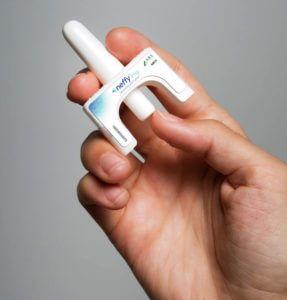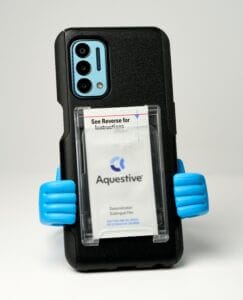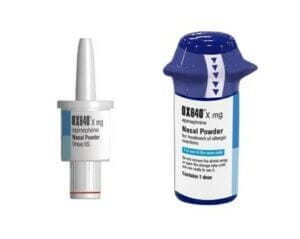Four companies are making progress on needle-free epinephrine auto-injector alternatives for treating serious allergic reactions. Contenders include two nasal sprays, a nasal powder, and a film that’s placed under the tongue and dissolves in seconds.
First in line is the nasal epinephrine sprayer from ARS Pharmaceuticals called neffy. On April 2, the company resubmitted its application for Food and Drug Administration approval. ARS Pharma had applied for approval in 2023, but was dealt a setback when the FDA declined to give the green light. Instead, the agency asked for an additional study.
That study is complete – and part of the company’s resubmission. “We look forward to working with the FDA in our efforts to make neffy available to allergy patients as soon as possible,” said ARS Pharma president and CEO Richard Lowenthal.
The FDA has until October 2, 2024 to issue a decision on whether it will approve the neffy epinephrine spray.
A second auto-injector alternative should also be ready to seek FDA approval in 2024 – an under-the-tongue film made by Aquestive Therapeutics, says Daniel Barber, the company’s president and CEO.
At least two other auto-injector alternatives are in the works: an epinephrine nasal spray developed by Bryn Pharma, and a nasal epinephrine powder made by the Swedish company, Orexo. The epinephrine powder is the newer entrant to a field of potential needle-free epinephrine products.
Epinephrine Sprays, Film Vs. Injectors
With the neffy and Bryn Pharma nasal sprays, as well as the Aquestive film, there have already been several studies. The three product makers recently shared new clinical trial results comparing their products against auto-injectors and epinephrine injected with a syringe.
There are nuances among them. However, the trials show that both nasal sprays and the film raise heart rate, blood pressure and levels of epinephrine in blood similarly to what’s seen with auto-injectors or epinephrine from a syringe.
These measurements indicate that the epinephrine is being absorbed and will work to treat real-world anaphylaxis, says Dr. Jay Lieberman, an allergist-immunologist at University of Tennessee Health Science Center. Called “pharmacokinetic” and “pharmacodynamic” data, the research is also what the FDA scrutinizes in approval consideration.
“All of these products are achieving what you would like to see,” Lieberman says. “These companies have shown pharmacokinetic and pharmacodynamic data that’s very promising and seems to be in line with what the FDA is wanting them to be able to mimic.”
Overall, “the differences among all of these products are very small,” he adds. Lieberman is chair of the food allergy committee for the American College of Allergy, Asthma, and Immunology.
All Eyes on neffy Epinephrine Spray

In the bid for approval, ARS Pharma’s neffy epinephrine sprayer was first out of the gate. In May 2023, an FDA advisory committee of independent experts recommended approval of the spray. But ARS Pharma was dealt a setback in September 2023 when the FDA declined to approve its 2 milligram sprayer for adults and children weighing 66 pounds or more.
ARS Pharma shared that the agency wanted to see a study of two doses of their nasal spray in people with nasal congestion from allergic rhinitis. In announcing the FDA resubmission, Lowenthal notes the “successful completion” of this study.
The FDA has six months from the submission date to render its decision. According to Lieberman, the other companies are closely watching.
“For these other companies, it’s all going to depend on what the FDA does with the ARS product. If the FDA continues to say ‘no’ to ARS, it may make their road to approval more difficult, says the allergist. He has worked as a consultant for ARS and Bryn Pharma.
In the meantime, the other epinephrine alternative makers continue to move forward with the necessary clinical trials. Here’s the latest on each.
Under-the-Tongue Epinephrine Film

Called Anaphylm, Aquestive Therapeutics’ sublingual film would be the only oral medication for treating serious allergic reactions.
In March 2024, a pivotal, Phase 3 trial involving 64 adults found that the time to reach peak concentration of epinephrine in the blood averaged 12 minutes with the dissolving film. That was faster than the other methods tested – 20 minutes for the EpiPen, 30 minutes for Auvi-Q, and 50 minutes for epinephrine given manually by syringe.
“It’s faster than both auto-injectors and much faster than manual injection,” Barber told Allergic Living.
The company’s research also shows that the time to reach the maximum concentration was clustered around 12 minutes with Anaphylm. Epinephrine injected into the muscle had more variability from patient to patient in how long it took to reach the peak.
A study in adults using a repeat dose of the film showed it took 10 minutes for the second dose to reach the peak. Barber says that rapid peak could be especially important because people who need a second dose often have worsening symptoms. (One analysis of studies found about 8 percent of people treated with epinephrine need a second dose to quell anaphylaxis.)
He calls the tight time to maximum concentration “ideal for those patients, because they will get a very quick amount of epinephrine” to treat symptoms.
In discussions with the FDA, it’s been determined that the instruction label will not require a warning against swallowing. When placed under the tongue, the film dissolves in seconds. Swallowing is OK, Barber says.
Anaphylm will come in a foil packet that can be slipped into a pocket, a wallet or even into a mobile phone case. The instructions will simply advise to take the film out of the foil packet and place under the tongue.
Anaphylm: OAS and Next Steps
Because Anaphylm is taken by mouth, the FDA has asked for a repeat dosing study in people having a reaction due to oral allergy syndrome, says Dr. Carl Kraus, Aquestive’s chief medical officer. People with oral allergen syndrome (OAS) develop localized symptoms such as itching, burning and swelling in the mouth from eating raw fruits and vegetables.
The study will enroll patients with OAS. Researchers will then “elicit a localized response in the oral cavity, and assess whether that has an impact on drug absorption,” Kraus says. The study protocol will be submitted to the FDA soon.
Barber says the company plans to file for approval of their 12 mg dose for adults and children 66 pounds and up by the end of 2024.
He says it’s unknown whether the FDA will ask the company to appear before an FDA advisory committee before approving, as it did with neffy. Members of these committees include doctors and other experts who provide independent advice to the FDA.
“There is some benefit to the advisory committee setting. We get to talk about our data, in a public forum, with a committee of physicians,” Barber says. “We don’t know if the FDA will require it, but we will definitely be ready if they do.”
Bryn Pharma’s Nasal Epinephrine

A second nasal sprayer is also making progress: Bryn Pharma’s epinephrine spray, called NDS1C in studies. It’s a 13.2 mg dose, delivered in two consecutive sprays. (A single dose of neffy, by comparison, is one spray.)
Two recent studies pooled data from four trials on more than 460 people. The trials found that the sprayer’s effect on levels of epinephrine in the blood is comparable to levels seen with a 0.3 mg auto-injector. Participants received a total of 13.2 mg of NDS1C: either two sprays in the same nostril or two sprays in opposite nostrils. For comparison, a third group had a single 0.3 mg auto-injector.
The time to reach peak concentration of epinephrine in the blood was 25 minutes for the nasal spray in opposite nostrils, 20 minutes for the nasal spray in the same nostril, and 20 minutes for the auto-injector. Changes in blood pressure and heart rate were similar using all three methods.
A repeat dosing study in 36 healthy adults found epinephrine absorption increased by 50 percent after the second dose. Two doses of the Bryn epinephrine sprayer are a total of four sprays. Side effects were mostly mild and included upper abdominal pain, nasal discomfort, headache, and nausea in some participants. There were no serious adverse events.
Bryn’s data was presented in February at the 2024 American Academy of Allergy, Asthma and Immunology meeting in Washington, D.C. A spokesperson for Bryn said by email: “The company is working to complete its clinical development and looks forward to working with the FDA to bring a needle-free option to the market as soon as possible.”
Fourth Contender: Epinephrine Powder

The fourth contender, the nasal epinephrine powder by Orexo, also shared clinical trial at the allergists’ meeting.
In a study, 40 healthy volunteers received four formulations of a 1 mg dose of the epinephrine powder. Results were compared against a 0.3 mg EpiPen, and there was a 24-hour break between all doses. The study’s purpose was to determine the optimal formulation for future clinical trials, says Martin Jonnson, a clinical pharmacologist with Orexo.
The study found that epinephrine blood levels peaked mostly rapidly with EpiPen. But by 6 to 10 minutes after administration, blood levels of epinephrine given via auto-injector and the powder were about the same. Heart rate and blood pressure increased more with the epinephrine powder than the EpiPen.
The powder dissolves quickly when it comes into contact with moisture inside the nose, Jonnson says.
The research also found the powder remains stable when stored in high temperatures. When kept at 104 degrees Fahrenheit for 12 months, the epinephrine powder hardly degraded. By comparison, the EpiPen had lost about 45 percent of its active drug in hot temperatures.
In November 2023, the FDA accepted Orexo’s new drug application using its powder technology and naloxone to treat opioid overdoses.
Next steps for their epinephrine powder include a trial in people with nasal congestion due to allergic rhinitis. Jonsson did not have a date for when that study would begin.
He acknowledges his company’s research isn’t as far along as the others. “Of course it’s a benefit to be first,” Jonnson says. “But we think we can bring something additional with our stability data.”
Is There a Race to Be First Alternative?
Lowenthal says neffy could be available in pharmacies within eight weeks of getting a green light from the FDA. Reimbursement from commercial insurers may take longer to arrange, from six months to a year.
From a marketing standpoint, Barber of Aquestive says all pharma companies would like to be first to get a novel epinephrine product approved. But “it’s not really a race.”
“The reality is once these products are available to patients, patients will make the ultimate choice and they will be doing that for years to come,” he says.
Cost, availability, and patient preference may all factor into those decisions.
Needle-Free Products: Different Dosing
Each of the auto-injector alternatives delivers a different dose of epinephrine. Neffy is a 2 mg sprayer. ARS Pharma is also developing a 1 mg sprayer for kids 30 to 66 pounds. Anaphylm is a 12 mg dose, while Bryn’s sprayer is a 13.2 mg dose.
In contrast, EpiPen and Auvi-Q are 0.3 mg doses.
Why the differences? It has to do with how epinephrine is absorbed through the different methods, Lieberman explains.
What matters most is absorption and the effect it has in the body. That’s what the pharmacokinetic and pharmacodynamic data in the trials measure.
Each company’s goal is to find a dose that achieves levels of epinephrine, heart rate and blood pressure that are within the range of epinephrine products already on the market – auto-injectors and the manual syringe.
Related Reading:
EU Poised to Approve Neffy Epi Spray – Will U.S. Soon Follow?
2023: FDA Declines Approval, Wants More Study of Neffy Epinephrine Spray
AAAAI Meeting: Neffy Epi Spray Halted Anaphylaxis in Kids
All About Epinephrine: What It Does, How Long It Lasts, When It Gets Hot, Cold





